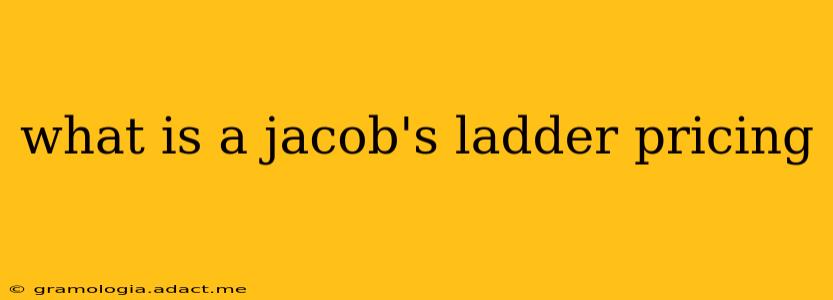Jacob's Ladder pricing, also sometimes referred to as price escalation or a price ladder, is a pricing strategy where a company offers a range of products or services at progressively higher price points. Each step up the "ladder" typically offers additional features, benefits, or a higher level of service. Think of it as a tiered system, with each tier building upon the previous one. This strategy isn't just about increasing price; it's about offering varying value propositions to cater to different customer needs and budgets.
This strategy is particularly effective when targeting a diverse market with varying levels of demand and willingness to pay. It allows businesses to capture a wider customer base, from budget-conscious consumers to those seeking premium options. Understanding how this pricing strategy works is key to successful implementation and maximizing profitability.
How Does Jacob's Ladder Pricing Work?
The core principle is simple: offer a basic product or service at a lower price point to attract a broader audience. Then, progressively add features, enhancements, or superior service levels at each subsequent price point. This creates a clear value hierarchy, making it easy for customers to understand the differences and justify the increased cost for higher tiers.
For example, a software company might offer a free version with limited features, a paid basic plan with more functionality, and a premium plan with advanced features and dedicated support. Similarly, a gym might offer a basic membership, a mid-tier membership with access to additional classes, and a premium membership with personalized training and access to exclusive amenities.
Why Use Jacob's Ladder Pricing?
There are several compelling reasons why businesses choose this strategic approach:
- Broader Market Reach: By offering different price points, you appeal to a wider range of customers, from those seeking value to those seeking premium experiences.
- Increased Revenue: The higher-priced tiers generate significantly more revenue than the lower tiers, contributing to overall profitability.
- Improved Customer Segmentation: This strategy allows for better targeting of specific customer segments based on their needs and budget.
- Enhanced Brand Perception: Offering a premium tier enhances brand image and positions the company as a provider of high-quality solutions.
- Improved Customer Lifetime Value (CLTV): Customers might start with a lower tier and upgrade as their needs evolve, leading to increased customer loyalty and lifetime value.
What are the Potential Downsides of Jacob's Ladder Pricing?
While Jacob's Ladder pricing offers significant advantages, it's essential to be aware of its potential drawbacks:
- Cannibalization: A poorly designed ladder might lead to cannibalization, where sales of higher-priced tiers are negatively impacted by the lower-priced options. Careful planning and differentiation are crucial to avoid this.
- Complexity: Managing multiple pricing tiers can be complex, requiring robust inventory management and marketing strategies.
- Customer Confusion: If the value proposition of each tier isn't clearly defined, customers might become confused and struggle to understand the differences.
How to Implement Jacob's Ladder Pricing Effectively
Success with this pricing strategy requires careful planning and execution. Consider these key steps:
- Define Your Value Propositions: Clearly articulate the unique value and benefits of each tier.
- Conduct Market Research: Understand your target market's needs, preferences, and willingness to pay.
- Analyze Competitor Pricing: See how competitors are structuring their pricing tiers.
- Test and Iterate: Monitor sales data and customer feedback to refine your pricing structure over time.
- Communicate Clearly: Ensure that the value proposition of each tier is clearly communicated to customers.
What are the differences between Jacob's Ladder Pricing and other pricing strategies?
This question highlights the importance of understanding the nuances of different pricing strategies. Jacob's Ladder pricing differs from simpler strategies like cost-plus pricing (adding a markup to the cost of goods) or value-based pricing (setting prices based on perceived customer value) because it involves a deliberate creation of multiple tiers with distinct value offerings. Unlike competitive pricing, which focuses on matching or undercutting competitors, Jacob's ladder aims to capture multiple market segments.
Is Jacob's Ladder Pricing Right for My Business?
The suitability of Jacob's Ladder pricing depends on various factors, including your industry, target market, and product/service offerings. It's generally most effective for businesses with products or services that can be tiered in terms of features, benefits, or service levels. If you're unsure, consulting with a pricing specialist might be helpful.
By carefully considering these factors and implementing the strategy effectively, businesses can leverage Jacob's Ladder pricing to achieve significant growth and profitability. Remember that clear communication, a well-defined value proposition for each tier, and ongoing monitoring are key to success.
